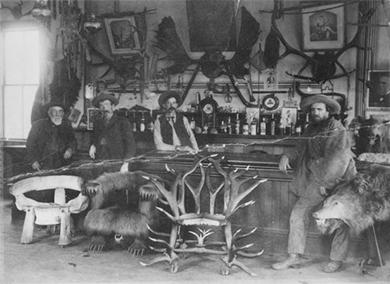Violence in the West: Myth and Reality
The popular image of the Wild West portrayed in books, television, and film has been one of violence and mayhem. The lure of quick riches through mining or driving cattle meant that much of the West did indeed consist of rough men living a rough life, although the violence was exaggerated and even glorified in the dime store novels of the day. The exploits of Wyatt Earp, Doc Holiday, and others made for good stories, but the reality was that western violence was more isolated than the stories might suggest. These clashes often occurred as people struggled for the scarce resources that could make or break their chance at riches, or as they dealt with the sudden wealth or poverty that prospecting provided.
Where sporadic violence did erupt, it was concentrated largely in mining towns or during range wars among large and small cattle ranchers. Some mining towns were indeed as rough as the popular stereotype. Men, money, liquor, and disappointment were a recipe for violence. Fights were frequent, deaths were commonplace, and frontier justice reigned. The notorious mining town of Bodie, California, had twenty-nine murders between 1877 and 1883, which translated to a murder rate higher than any other city at that time, and only one person was ever convicted of a crime. The most prolific gunman of the day was John Wesley Hardin, who allegedly killed over twenty men in Texas in various gunfights, including one victim he killed in a hotel for snoring too loudly (Figure 17.12).

Ranching brought with it its own dangers and violence. In the Texas cattle lands, owners of large ranches took advantage of their wealth and the new invention of barbed wire to claim the prime grazing lands and few significant watering holes for their herds. Those seeking only to move their few head of cattle to market grew increasingly frustrated at their inability to find even a blade of grass for their meager herds. Eventually, frustration turned to violence, as several ranchers resorted to vandalizing the barbed wire fences to gain access to grass and water for their steers. Such vandalism quickly led to cattle rustling, as these cowboys were not averse to leading a few of the rancher’s steers into their own herds as they left.
One example of the violence that bubbled up was the infamous Fence Cutting War in Clay County, Texas (1883–1884). There, cowboys began destroying fences that several ranchers erected along public lands: land they had no right to enclose. Confrontations between the cowboys and armed guards hired by the ranchers resulted in three deaths—hardly a “war,” but enough of a problem to get the governor’s attention. Eventually, a special session of the Texas legislature addressed the problem by passing laws to outlaw fence cutting, but also forced ranchers to remove fences illegally erected along public lands, as well as to place gates for passage where public areas adjoined private lands.
An even more violent confrontation occurred between large ranchers and small farmers in Johnson County, Wyoming, where cattle ranchers organized a “lynching bee” in 1891–1892 to make examples of cattle rustlers. Hiring twenty-two “invaders” from Texas to serve as hired guns, the ranch owners and their foremen hunted and subsequently killed the two rustlers best known for organizing the owners of the smaller Wyoming farms. Only the intervention of federal troops, who arrested and then later released the invaders, allowing them to return to Texas, prevented a greater massacre.
While there is much talk—both real and mythical—of the rough men who lived this life, relatively few women experienced it. While homesteaders were often families, gold speculators and cowboys tended to be single men in pursuit of fortune. The few women who went to these wild outposts were typically prostitutes, and even their numbers were limited. In 1860, in the Comstock Lode region of Nevada, for example, there were reportedly only thirty women total in a town of twenty-five hundred men. Some of the “painted ladies” who began as prostitutes eventually owned brothels and emerged as businesswomen in their own right; however, life for these young women remained a challenging one as western settlement progressed. A handful of women, numbering no more than six hundred, braved both the elements and male-dominated culture to become teachers in several of the more established cities in the West. Even fewer arrived to support husbands or operate stores in these mining towns.
As wealthy men brought their families west, the lawless landscape began to change slowly. Abilene, Kansas, is one example of a lawless town, replete with prostitutes, gambling, and other vices, transformed when middle-class women arrived in the 1880s with their cattle baron husbands. These women began to organize churches, school, civic clubs, and other community programs to promote family values. They fought to remove opportunities for prostitution and all the other vices that they felt threatened the values that they held dear. Protestant missionaries eventually joined the women in their efforts, and, while they were not widely successful, they did bring greater attention to the problems. As a response, the U.S. Congress passed both the Comstock Law (named after its chief proponent, anti-obscenity crusader Anthony Comstock) in 1873 to ban the spread of “lewd and lascivious literature” through the mail and the subsequent Page Act of 1875 to prohibit the transportation of women into the United States for employment as prostitutes. However, the “houses of ill repute” continued to operate and remained popular throughout the West despite the efforts of reformers.

